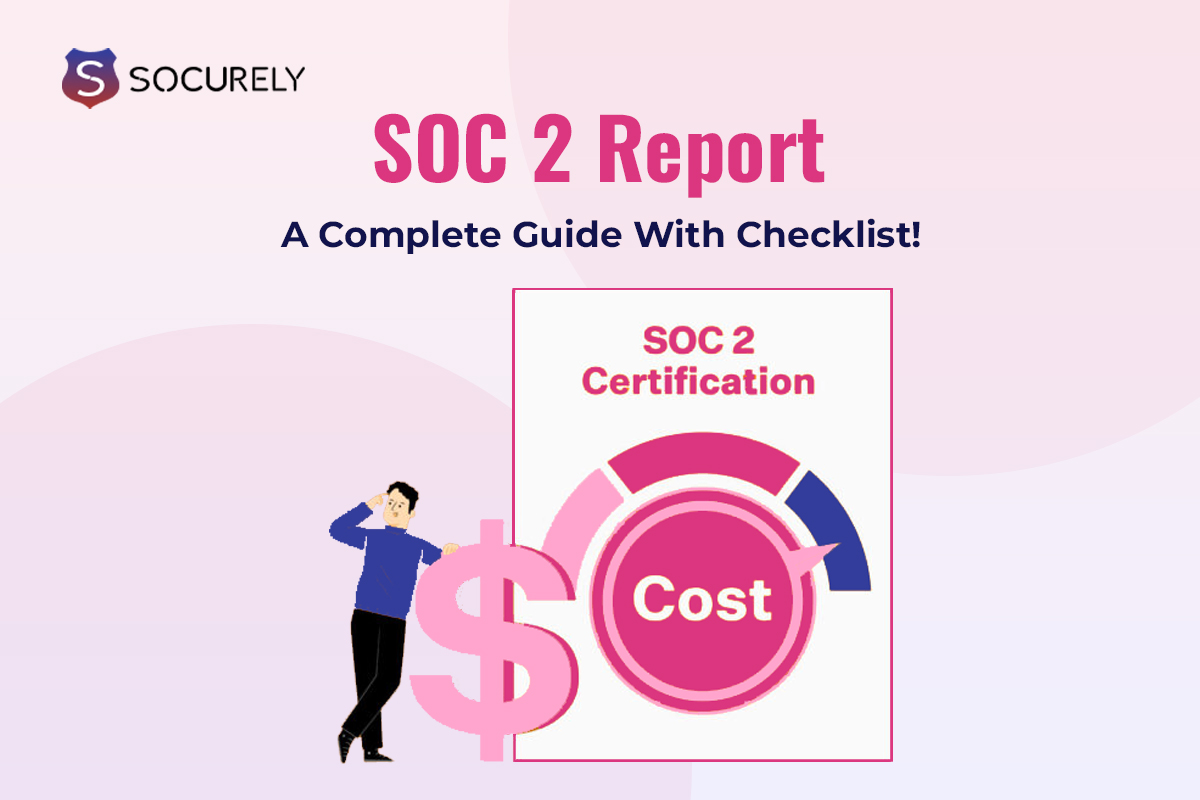Do you know in this era of modernization, safeguarding business data with customer integration is mostly important? But how do you perform that security? It is the power of compliance security offered by the SOC 2 framework, ISO 27001 Certification, PCI DSS framework, and more.
Whether you are a professional business icon, or a small startup, getting compliance security is the transformative goal. It enhances the security posture with the commitment to data protection and operational excellence.
First, you understand that every framework serves a different purpose for your business security. ISO 27001 Certification ensures the security standards, while PCI DSS secures your payment gateways with reports.
In this blog, we will walk through the SOC 2 Report compliance in detail, so that you can boost your business’s credibility, and ultimately secure more growth opportunities.
Let’s dive in and transform the way you handle data security!
What Are Compliance Reports?
Compliance reports are critical documents that validate a company’s adherence to industry standards and regulations. These are frameworks that assure customers, stakeholders, and partners that the company takes data security seriously.
Let’s look at some of the most common compliance reports:
- PCI DSS Reports: The Payment Card Industry Data Security Standard (PCI DSS) report is crucial for businesses that handle credit card information. It ensures that all card transactions are secure and protected against fraud.
- ISO Reports: The International Organization for Standardization (ISO) provides several standards, with ISO 27001 being one of the most sought-after for information security management. ISO 27001 reports certify that a company’s information security management system (ISMS) meets international standards.
Introducing SOC 2 Reports
SOC 2, which stands for System and Organization Controls 2, is specifically designed for service providers storing customer data in the cloud. It ensures that service organizations manage customer data based on five “trust service principles”—security, availability, processing integrity, confidentiality, and privacy.
The Five Trust Service Criteria Include-
- Security- This is the mandatory category of TSC. Using this businesses can protect their system and information from damage, disclosure, and fraud. It protects the availability, integrity, confidentiality, and privacy of information or system integration.
- Availability- This criterion ensures that the system is available for operation and use as committed or agreed upon. It covers the accessibility of the system, including maintenance of hardware, software, data, and other infrastructural components.
- Process Integrity- It ensures that the system processing is complete, valid, accurate, timely, and authorized. It focuses on whether the system achieves its intended purpose without errors, delays, or unauthorized alterations.
- Confidentiality- Using this, information designated as confidential is protected as committed or agreed. It includes measures to protect data from unauthorized access and disclosure, ensuring that sensitive information remains private.
- Privacy- This criterion addresses how personal information is collected, used, retained, disclosed, and disposed of in conformity with the entity’s privacy notice and with criteria outlined in generally accepted privacy principles issued by the American Institute of Certified Public Accountants (AICPA). It ensures that personal data is handled with the utmost care and following established privacy regulations.
Understanding SOC 2 Audit
The SOC 2 audit is a rigorous evaluation process conducted by an independent auditor or auditor of a compliance company. This audit assesses a service organization’s controls to meet the trust service principles. The audit process involves several stages:
- Scoping: Determining the boundaries of the audit, including which systems and processes will be evaluated.
- Readiness Assessment: Preparing for the audit by identifying gaps and implementing necessary controls.
- Fieldwork: The auditor collects evidence and evaluates the effectiveness of controls.
- Report Preparation: The auditor compiles findings into a comprehensive report.
Understanding SOC 2 Report
A SOC 2 report is the final output of the audit. It provides a detailed assessment of the organization’s controls and how they meet the trust service principles. There are two types of SOC 2 reports:
- SOC 2 Type I Report: SOC 2 Type I report describes an organization’s systems and whether their design meets the relevant trust principles at a specific point in time.
- SOC 2 Type II Report: This report goes a step further by evaluating the operational effectiveness of these systems over some time, typically six months.
Things A SOC 2 Report Includes
SOC 2 reports are requested for the auditor’s view on their evaluation of the organization’s controls in addition to general information about the audited companies. It also includes an explanation of the tests that were conducted and, if necessary, suggestions for enhancing data security practices. To carry out your audit, you must choose a CPA (company or individual) with AICPA accreditation.
SOC 2 reports often comprise these subsequent sections:
Management’s Description of the System: An overview of the organization’s system and processes. The system(s), scope & requirements, components, controls, and other system information are all described in this important area. This section goes into depth on information and communication systems, monitoring, risk assessments, and control activities (policies and procedures).
Management’s Assertion: A statement from management asserting that the system meets the trust service principles. Also, written by the audited organization, the part includes the overview of the services, goods, applications, systems, structures, and security measures of the company. The management accepts the accuracy and applicability of the information supplied.
Auditor’s Opinion: The auditor’s evaluation and opinion on whether the controls are suitably designed and operating effectively. The opinion of the Auditor further is divided into 4 types
- Unqualified – You pass with flying colors! The auditor’s unqualified opinion indicates that the auditor found no issues during the SOC 2 audit. It identifies there remain no design errors in any of the controls tested (Soc 2 Type 1 report), nor any operational problems (Type 2 report).
- Qualified – Close, but not quite! This means that some areas need attention. Do you know what is not worthy of a qualified report? Well, it includes the failed controls and the later effect on the report’s users.
- Adverse – You failed! An adverse opinion signifies the failed standards (one or more) of the organization materially, which further makes the controls and system non-reliable.
- Disclaimer of Opinion – No comments! This isn’t an opinion! Due to this failure of opinion, the auditor fails to form an opinion based on the provided information. This mainly takes place when auditors do not have access to the required information or cannot complete it neutrally.
Description of Tests of Controls: Details of the tests performed by the auditor to assess control effectiveness. It is essential to the report as it provides an overview and outcomes during the audit. This part also sheds light on the auditor’s view while deciding the organization’s personnel, data, processes, software, infrastructure, and procedures to be audited.
Results of Tests: The outcomes of these tests, highlight any issues or areas for improvement. The Trust Service Principle (previously known as SOC 2) of SOC 2 Type 1 and SOC 2 Type 2 reports are comparable in the previous parts, however, this portion is very different! It identifies the results for betterment.
Here, a list of all the controls that were assessed during the audit is included in the Type 1 report. Together with the test findings for each indicated control, the Type 2 report will also include the auditor’s tests. This portion of a Type 2 report will also detail any deviations or exceptions that the auditor has seen.
Importance Of SOC 2 Report
SOC 2 Report is the written proof that claims that you are SOC 2 Compliant. It is important for all businesses but adds more light for small businesses.
Achieving SOC 2 Compliance for small businesses is a game-changer. Here’s why:
- Building Trust: A SOC 2 report demonstrates to clients and partners that your organization takes data security seriously. Competitive markets can make this a significant differentiator.
- Regulatory Compliance: Different industries follow various stringent data protection regulations. A SOC 2 report can help ensure compliance and avoid hefty fines.
- Operational Efficiency: The process of preparing for a SOC 2 audit often uncovers inefficiencies and gaps in processes, leading to overall operational improvements.
- Market Expansion: Many larger enterprises require their vendors to have SOC 2 compliance. Achieving this can open doors to new business opportunities.
How Socurely Helps With SOC 2 Report?
Compliance with SOC 2 can be complex. This is where Socurely comes in. We specialize in helping businesses of all sizes achieve and maintain SOC 2 compliance. Here’s how we can assist:
- Readiness Assessments: We conduct thorough readiness assessments to identify gaps and provide actionable recommendations.
- Policy Development: Our experts help you develop and implement robust security policies tailored to meet SOC 2 requirements.
- Continuous Monitoring: We offer continuous monitoring services to ensure that your controls remain effective and compliant.
- Audit Support: Our team provides comprehensive support throughout the audit process, from initial scoping to final report preparation.
Get The SOC 2 Checklist With Us!
Preparing for a SOC 2 audit can be overwhelming, but having a clear checklist can make the process much more manageable. At Socurely, we offer a free SOC 2 checklist to guide you through each step of the compliance journey. Our SOC 2 checklist includes:
- Identification of Scope: Determine which systems and processes need to be audited.
- Gap Analysis: Identify any gaps in your current controls and processes.
- Policy and Procedure Documentation: Ensure all necessary policies and procedures are documented.
- Control Implementation: Implement the required controls to meet SOC 2 standards.
- Readiness Assessment: Conduct a readiness assessment to ensure you are fully prepared for the audit.
FAQ
- What is the average time it takes to prepare a SOC 2 report?
The time it takes to prepare a SOC 2 report can vary depending on the organization’s size and complexity. Typically, the process can take anywhere from three to twelve months. This includes time for scoping, implementing controls, and undergoing the audit.
- How much does SOC 2 report preparation cost?
The cost of preparing a SOC 2 report can also vary widely. Factors such as the size of the organization, the complexity of systems, and the scope of the audit all play a role. On average, businesses can expect to invest between $20,000 and $100,000 for the entire process.
- When to get your SOC 2 report renewed?
SOC 2 reports are typically valid for 12 months from the date of issuance. It is advisable to start the renewal process several months before the expiration of the current report to ensure continuous compliance. Regular renewal not only maintains your compliance status but also reassures clients and stakeholders that your data security measures are consistently upheld.
Conclusion
Achieving SOC 2 compliance is an important decision, but not mandatory for any organization. It not only builds trust with clients and partners but also ensures that your data security practices meet the highest standards. By following this complete guide and utilizing the free SOC 2 checklist from Socurely, you can streamline your compliance journey and achieve the SOC 2 report with confidence.







